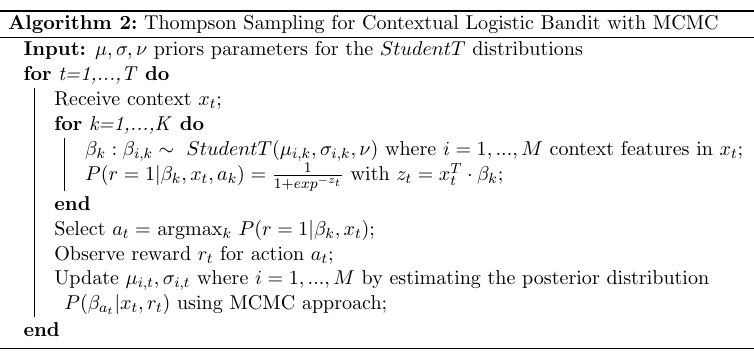Contextual Multi-Armed Bandit
For the contextual multi-armed bandit (sMAB) when user information is available (context), we implemented a generalisation of Thompson sampling algorithm (Agrawal and Goyal, 2014) based on PyMC.

The following notebook contains an example of usage of the class Cmab, which implements the algorithm above.
[1]:
import numpy as np
from pybandits.cmab import CmabBernoulli
from pybandits.model import BayesianLogisticRegression, BnnLayerParams, BnnParams, StudentTArray
[2]:
n_samples = 1000
n_features = 5
First, we need to define the input context matrix \(X\) of size (\(n\_samples, n\_features\)) and the mapping of possible actions \(a_i \in A\) to their associated model.
[3]:
# context
X = 2 * np.random.random_sample((n_samples, n_features)) - 1 # random float in the interval (-1, 1)
print("X: context matrix of shape (n_samples, n_features)")
print(X[:10])
X: context matrix of shape (n_samples, n_features)
[[ 0.94561871 0.49063357 0.33739942 0.03655436 0.26077246]
[-0.69399276 0.07521541 0.89467689 0.5823588 0.69853339]
[ 0.47312755 0.01447004 -0.45343319 0.35787815 0.59208572]
[-0.54208797 0.72184161 0.84282483 -0.23865498 0.41134219]
[-0.09232342 0.11872678 -0.58219639 -0.76967185 -0.50337173]
[-0.14192811 0.66007117 -0.98815161 0.67774466 -0.59587899]
[-0.07108369 0.17160536 -0.89502239 0.52986151 -0.0789072 ]
[-0.67693835 0.81967232 -0.93751686 0.89820483 -0.10813707]
[-0.6050155 0.26469164 0.28907946 -0.83948365 0.86996626]
[ 0.2570248 -0.15237458 0.86910412 -0.76167487 -0.53368498]]
[4]:
# define action model
bias = StudentTArray.cold_start(mu=1, sigma=2, shape=1)
weight = StudentTArray.cold_start(shape=(n_features, 1))
layer_params = BnnLayerParams(weight=weight, bias=bias)
model_params = BnnParams(bnn_layer_params=[layer_params])
update_method = "VI"
update_kwargs = {"fit": {"n": 100}, "batch_size": 128, "optimizer_type": "adam"}
actions = {
"a1": BayesianLogisticRegression(
model_params=model_params, update_method=update_method, update_kwargs=update_kwargs
),
"a2": BayesianLogisticRegression(
model_params=model_params, update_method=update_method, update_kwargs=update_kwargs
),
}
We can now init the bandit given the mapping of actions \(a_i\) to their model.
[5]:
# init contextual Multi-Armed Bandit model
cmab = CmabBernoulli(actions=actions)
The predict function below returns the action selected by the bandit at time \(t\): \(a_t = argmax_k P(r=1|\beta_k, x_t)\). The bandit selects one action per each sample of the contect matrix \(X\).
[6]:
# predict action
pred_actions, _, _ = cmab.predict(X)
print("Recommended action: {}".format(pred_actions[:10]))
Recommended action: ['a2', 'a1', 'a2', 'a2', 'a2', 'a2', 'a2', 'a1', 'a2', 'a2']
Now, we observe the rewards and the context from the environment. In this example rewards and the context are randomly simulated.
[7]:
# simulate reward from environment
simulated_rewards = np.random.randint(2, size=n_samples).tolist()
print("Simulated rewards: {}".format(simulated_rewards[:10]))
Simulated rewards: [0, 0, 1, 0, 1, 1, 1, 1, 1, 0]
Finally, we update the model providing per each action sample: (i) its context \(x_t\) (ii) the action \(a_t\) selected by the bandit, (iii) the corresponding reward \(r_t\).
[8]:
# update model
cmab.update(context=X, actions=pred_actions, rewards=simulated_rewards)
/home/runner/.cache/pypoetry/virtualenvs/pybandits-vYJB-miV-py3.10/lib/python3.10/site-packages/pymc/model/core.py:1238: UserWarning: total_size not provided for observed variable `out` that uses pm.Minibatch
warnings.warn(
/home/runner/.cache/pypoetry/virtualenvs/pybandits-vYJB-miV-py3.10/lib/python3.10/site-packages/pytensor/link/c/cmodule.py:2968: UserWarning: PyTensor could not link to a BLAS installation. Operations that might benefit from BLAS will be severely degraded.
This usually happens when PyTensor is installed via pip. We recommend it be installed via conda/mamba/pixi instead.
Alternatively, you can use an experimental backend such as Numba or JAX that perform their own BLAS optimizations, by setting `pytensor.config.mode == 'NUMBA'` or passing `mode='NUMBA'` when compiling a PyTensor function.
For more options and details see https://pytensor.readthedocs.io/en/latest/troubleshooting.html#how-do-i-configure-test-my-blas-library
warnings.warn(
/home/runner/.cache/pypoetry/virtualenvs/pybandits-vYJB-miV-py3.10/lib/python3.10/site-packages/rich/live.py:256:
UserWarning: install "ipywidgets" for Jupyter support
warnings.warn('install "ipywidgets" for Jupyter support')
/home/runner/.cache/pypoetry/virtualenvs/pybandits-vYJB-miV-py3.10/lib/python3.10/site-packages/pymc/model/core.py:1238: UserWarning: total_size not provided for observed variable `out` that uses pm.Minibatch
warnings.warn(
/home/runner/.cache/pypoetry/virtualenvs/pybandits-vYJB-miV-py3.10/lib/python3.10/site-packages/rich/live.py:256:
UserWarning: install "ipywidgets" for Jupyter support
warnings.warn('install "ipywidgets" for Jupyter support')